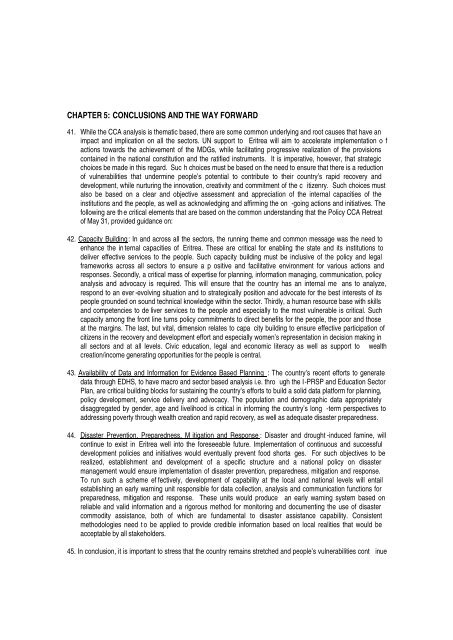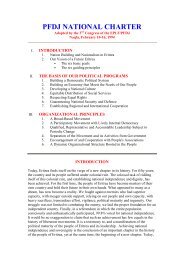Common Country Assessment (CCA) - ECSS | Eritrean Center for ...
Common Country Assessment (CCA) - ECSS | Eritrean Center for ...
Common Country Assessment (CCA) - ECSS | Eritrean Center for ...
Create successful ePaper yourself
Turn your PDF publications into a flip-book with our unique Google optimized e-Paper software.
CHAPTER 5: CONCLUSIONS AND THE WAY FORWARD<br />
41. While the <strong>CCA</strong> analysis is thematic based, there are some common underlying and root causes that have an<br />
impact and implication on all the sectors. UN support to Eritrea will aim to accelerate implementation o f<br />
actions towards the achievement of the MDGs, while facilitating progressive realization of the provisions<br />
contained in the national constitution and the ratified instruments. It is imperative, however, that strategic<br />
choices be made in this regard. Suc h choices must be based on the need to ensure that there is a reduction<br />
of vulnerabilities that undermine people’s potential to contribute to their country’s rapid recovery and<br />
development, while nurturing the innovation, creativity and commitment of the c itizenry. Such choices must<br />
also be based on a clear and objective assessment and appreciation of the internal capacities of the<br />
institutions and the people, as well as acknowledging and affirming the on -going actions and initiatives. The<br />
following are th e critical elements that are based on the common understanding that the Policy <strong>CCA</strong> Retreat<br />
of May 31, provided guidance on:<br />
42. Capacity Building: In and across all the sectors, the running theme and common message was the need to<br />
enhance the in ternal capacities of Eritrea. These are critical <strong>for</strong> enabling the state and its institutions to<br />
deliver effective services to the people. Such capacity building must be inclusive of the policy and legal<br />
frameworks across all sectors to ensure a p ositive and facilitative environment <strong>for</strong> various actions and<br />
responses. Secondly, a critical mass of expertise <strong>for</strong> planning, in<strong>for</strong>mation managing, communication, policy<br />
analysis and advocacy is required. This will ensure that the country has an internal me ans to analyze,<br />
respond to an ever -evolving situation and to strategically position and advocate <strong>for</strong> the best interests of its<br />
people grounded on sound technical knowledge within the sector. Thirdly, a human resource base with skills<br />
and competencies to de liver services to the people and especially to the most vulnerable is critical. Such<br />
capacity among the front line turns policy commitments to direct benefits <strong>for</strong> the people, the poor and those<br />
at the margins. The last, but vital, dimension relates to capa city building to ensure effective participation of<br />
citizens in the recovery and development ef<strong>for</strong>t and especially women’s representation in decision making in<br />
all sectors and at all levels. Civic education, legal and economic literacy as well as support to wealth<br />
creation/income generating opportunities <strong>for</strong> the people is central.<br />
43. Availability of Data and In<strong>for</strong>mation <strong>for</strong> Evidence Based Planning : The country’s recent ef<strong>for</strong>ts to generate<br />
data through EDHS, to have macro and sector based analysis i.e. thro ugh the I-PRSP and Education Sector<br />
Plan, are critical building blocks <strong>for</strong> sustaining the country’s ef<strong>for</strong>ts to build a solid data plat<strong>for</strong>m <strong>for</strong> planning,<br />
policy development, service delivery and advocacy. The population and demographic data appropriately<br />
disaggregated by gender, age and livelihood is critical in in<strong>for</strong>ming the country’s long -term perspectives to<br />
addressing poverty through wealth creation and rapid recovery, as well as adequate disaster preparedness.<br />
44. Disaster Prevention, Preparedness, M itigation and Response : Disaster and drought -induced famine, will<br />
continue to exist in Eritrea well into the <strong>for</strong>eseeable future. Implementation of continuous and successful<br />
development policies and initiatives would eventually prevent food shorta ges. For such objectives to be<br />
realized, establishment and development of a specific structure and a national policy on disaster<br />
management would ensure implementation of disaster prevention, preparedness, mitigation and response.<br />
To run such a scheme ef fectively, development of capability at the local and national levels will entail<br />
establishing an early warning unit responsible <strong>for</strong> data collection, analysis and communication functions <strong>for</strong><br />
preparedness, mitigation and response. These units would produce an early warning system based on<br />
reliable and valid in<strong>for</strong>mation and a rigorous method <strong>for</strong> monitoring and documenting the use of disaster<br />
commodity assistance, both of which are fundamental to disaster assistance capability. Consistent<br />
methodologies need t o be applied to provide credible in<strong>for</strong>mation based on local realities that would be<br />
acceptable by all stakeholders.<br />
45. In conclusion, it is important to stress that the country remains stretched and people’s vulnerabilities cont inue





